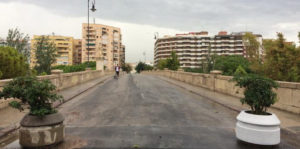I went to an interesting exhibition about cities development in Valencia, Spain, last January. The first part dealt with the conflicts between personal interests among the different actors in the cities regarding mobility, and why dialogue is essential to overcome them. Common claims such as I want to walk on the streets without fear, Children need to play on streets, What about disabled people, I want to sleep at nights (referring to those people living at nightlife areas), etc. were treated.
In the second part specific changes in several cities to improve sustainability and prioritize the more human ways of transport from the bicycle to the public transport, and among all making cities for people were shown. From this, I discover urb-i on which you can find at least 3,300 real examples of this kind of actions. Then, the memory of Jane Jacobs was highlighted as a clear pioneer in the study of cities from the anthropological point of view. Derived from this, I watched an extremely interesting documentary which can be free accessed at www.lifebetweenbuildingsfilm.org. I strongly recommend it.
Finally, a series of pictures and short texts explained the evolution of Valencia in the last century. To sum it up, at the beginning of the 19th century most of the city surface was used mainly by pedestrians. Moreover, there were some chariots to carry goods. In the 30’s, cars appeared as a distinction symbol, but in the 60’s and as more people had one, the concept of car = status symbol disappeared. As time went by, the car lobby invested (and still does) huge figures in marketing and most of citizens entrapped in the circle. The end of the time series was dedicated to the present actions to improve sustainable mobility and how perhaps the future will be. I am sure the history of urban mobility is similar to the Valencian.



